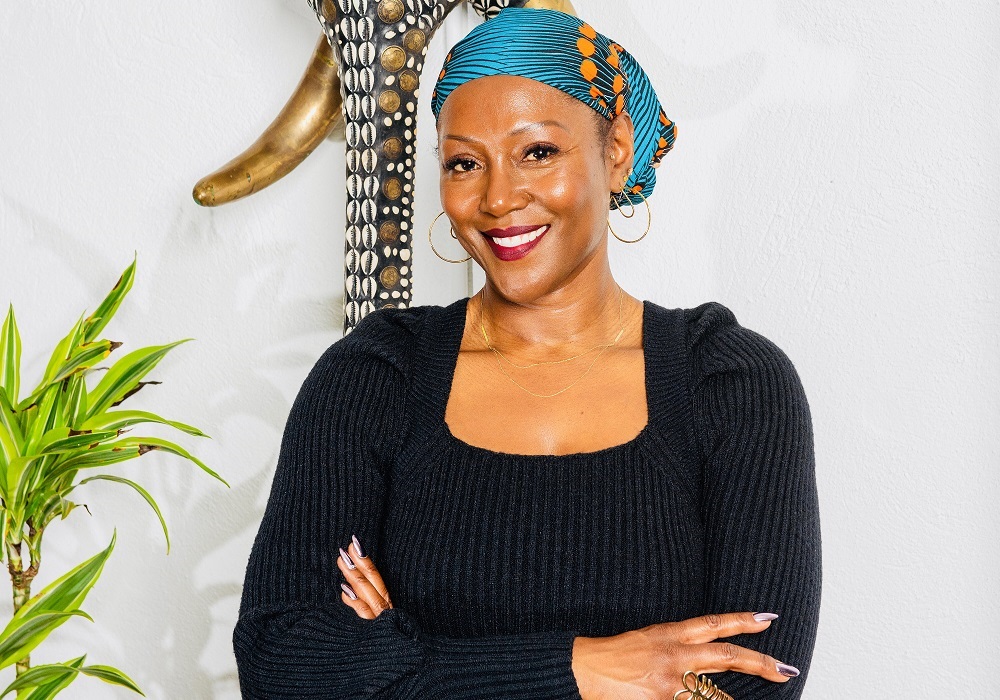Author and academic Monique Couvson became the first CEO of the recently launched philanthropic institution Grantmakers for Girls of Color in the spring of 2020. At the time, COVID-19 pandemic was in full swing and the country was on the verge of erupting in a racial justice reckoning catalyzed by the police murder of George Floyd.
While several large efforts existed to support Black men — My Brother’s Keeper and the Campaign for Black Male Achievement, for example — Grantmakers for Girls of Color emerged as the nation’s only philanthropic intermediary exclusively for girls of color and trans girls. Since then, with Couvson at the helm, she said that Grantmakers for Girls of Color (or G4GC) has given $16 million to more than 250 organizations dedicated to addressing the disproportionate impacts racism has on girls of color.
The organization’s funders include Pivotal Ventures, the venture capital firm founded by Melinda French Gates; Fondation CHANEL; the Skoll Foundation, the philanthropy led by former eBay President Jeff Skoll; the Chan Zuckerberg Initiative; the Wellspring Philanthropic Fund; the Hilton Foundation; and MacKenzie Scott, the philanthropist, author and ex-wife of Amazon founder Jeff Bezos.
Couvson’s role at Grantmakers for Girls of Color builds on her research and advocacy on how social policies, primarily in education, intersect with race, gender and justice to impact communities of color.
“Grantmakers for Girls of Color was not only an opportunity for us to have conversations but also to intentionally mobilize resources, activate learning and hold some of the political education as to why investing in girls of color is important,” Couvson said.
Grantmakers for Girls of Color has four funds:
- Love is Healing: General fund launched in response to the pandemic.
- Black Girl Freedom: Largest fund; Part of the #1billion4blackgirls campaign to raise $1 billion for Black girls and their families over a ten-year period between 2020 and 2030.
- New Songs Rising Initiative: A partnership with the Seventh Generation Fund for Indigenous People to expand support opportunities for Indigenous girls.
- Holding a Sister Initiative: A fund for trans girls of color in partnership with the Black Trans Fund.
The interview
Why did you accept the role of CEO and president of Grantmakers for Girls of Color?
When the opportunity to lead G4GC was made available to me, it felt like the next iteration of my work, the next iteration of my contribution to the conversations about how we support girls of color. I had produced, written and was lecturing widely on many of these issues. I had been involved in the scholar advocacy community for decades. I already knew a lot of people in this field and was already familiar with the prevailing and emergent issues impacting girls and femmes of color. It felt right, and it felt important, to have someone like me in a position of leadership in philanthropy.
Two years in, how is it going?
We’ve been able to move more than $16 million to more than 250 organizations around the country. So, I would say it’s going great. We’re really excited about how we’ve been able to leverage a lot of our pre-existing relationships and to really deepen our understanding of how to best respond to the conditions of girls of color. As I mentioned, I came on as the first CEO in April 2020. We launched at a very critical point in terms of public recognition of the global pandemic and at the time when people were elevating their own awareness about some of the racial conditions that disproportionately impact the communities where our girls live and come from. It was a very tumultuous time and also a very special time to be able to craft responses that were rooted in healing.
A big part of Grantmakers for Girls of Color is including the voices of the young people your philanthropy aims to impact. Can you tell me more about how that works?
In the spring of 2022, we announced we had moved about $4 million to 68 organizations. Black girls and femmes were the final decision-makers on who gets those resources. It was a beautiful thing to be able to encounter organizations that were receiving those funds because they knew they had been selected by girls, and they knew that their work was valued by girls and assessed with a degree of rigor that many times adults don’t have. We’re not girls anymore, right? We’re not young people living this experience today.
The intention at G4GC has always been to place young people at the center, not just as recipients of grants, but also as decision-makers. In a lot of ways, we’re ceding power. When we cede power to young people, when we invest in their ability to feel strong and competent in the mobilization of resources to support their own well-being, what we’re doing is relocating this notion of how knowledge is controlled and where the expertise lies.
What are some unexpected results that have come from letting young people act as decision-makers?
When we engage young people, we have to change how we work. A 9-to-5 work day is often not going to work within the schedule of young people. That means we might have to work on Saturdays.
My favorite quote is from one of our girls who said she didn’t realize a “Black girl from rural Mississippi could be a philanthropist.” She never considered that her experience would qualify her to become a philanthropist in real-time. Not that she couldn’t one day become a philanthropist but that she could be one today.
Young people have a very intentional, specific analysis of justice in this nation. Young people are uniquely equipped to hold us accountable, and often do hold us accountable as adults and others with power in society to do what’s right or to be fair. Imagine what we’ll have in the future if we invest in their capacity to transform our communities right now.
How do you find grantees?
There is a space on our website for organizations that are interested in reaching out to us to contact us and tell us what they do and to see if we can find some alignment and provide some support.
As a new grantmaking institution, we rapidly were able to identify organizations that were working with girls of color throughout the country by asking many of our pre-existing grantees who they work with and who they trust in their communities with certain aspects of the work that is being led by and focusing on girls, femmes and gender-expansive youth of color.
Can you talk about some of the barriers girls of color face that you focus on?
My area of scholarship is on education at the intersections of race, gender and justice. I spend a lot of time exploring the unique ways that educational institutions respond to and the decisions that impact Black girls and other girls of color, particularly around school discipline. There’s a lot of work to do to address some of the lingering structures that criminalize black girls or that render them vulnerable to disproportionately negative punitive treatment in schools. I would still like to see a robust, deeply coordinated effort to respond to some of the lingering issues that we see impacting the learning of Black girls and other girls of color.
What I’m encouraged by and what I have seen more of in this position at Grantmakers for Girls of Color are the responses to these lingering impacts. A lot of these organizations, led by women of color, are going into schools, into afterschool programs, and offering a unique modality that can respond to some of these issues. These organizations are developing curricula in schools, working with girls who are survivors of sexual violence and partnering with schools and school districts around a revision and review of some of their policies.
Maybe this is off-topic, maybe not. You have a substantial Twitter following of over 11,000. Are you planning on leaving now that Elon Musk has taken over?
I left Twitter. I said a long time ago that I was not going to willingly participate in my own oppression. And that includes putting myself and making myself available on platforms where there are egregious actions and representations of violence and the decision to make it a place that welcomes that kind of violence in the name of quote-unquote free speech. It wasn’t right for me. So I left. We have to do better in this human experience. We got to do better.
The details
Residence: New York City
Family: Two daughters
Title: President and CEO of Grantmakers for Girls of Color
Hobbies: Used to paint; read a lot; dance.
Recent reads: “Why Should White Guys Have All the Fun?” by Blair S. Walker and Reginald Lewis
First paid job: Legitimate paid: student teacher. Under the table: domestic work.
Previous Jobs: Co-founder and President of the National Black Women’s Justice Institute
Education: Bachelor of Arts, Columbia University; Master of Science in Urban Planning, Columbia University; Doctor of Education, Fielding Graduate University
Other work: Author of six books. The latest is “Cultivating Joyful Learning Spaces for Black Girls: Insights into Interrupting School Pushout.” Her forthcoming book in May is “Charisma’s Turn: A Graphic Novel.”
***
Brian Rinker is a San Francisco-based freelance writer and journalist. He covers public health, child welfare, digital health, startups and venture capital. His work has been published by Kaiser Health News, Health Affairs, The Atlantic, Men’s Health and San Francisco Business Times. Brian received master’s degrees in journalism and public health from UC Berkeley.




























